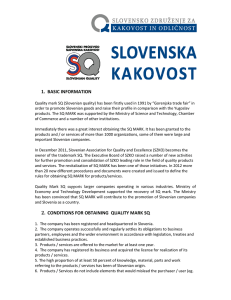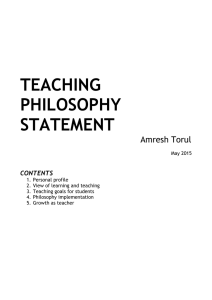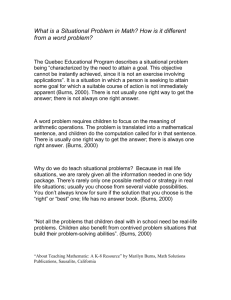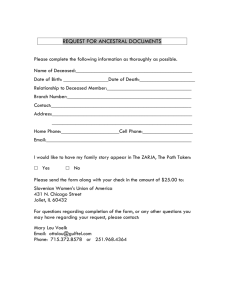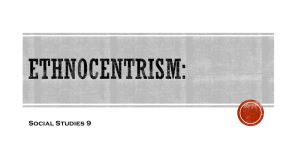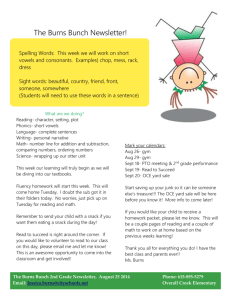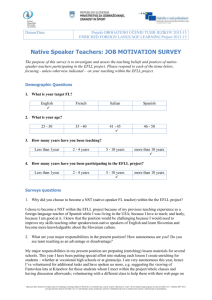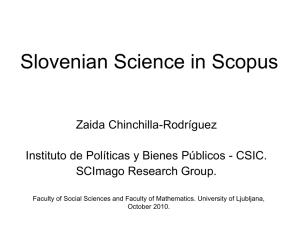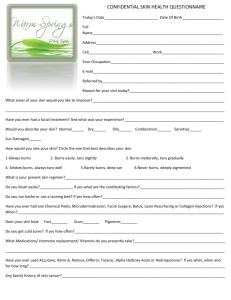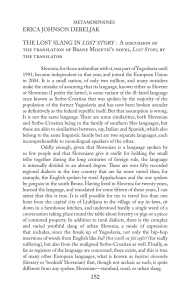teaching philosophy statement
advertisement
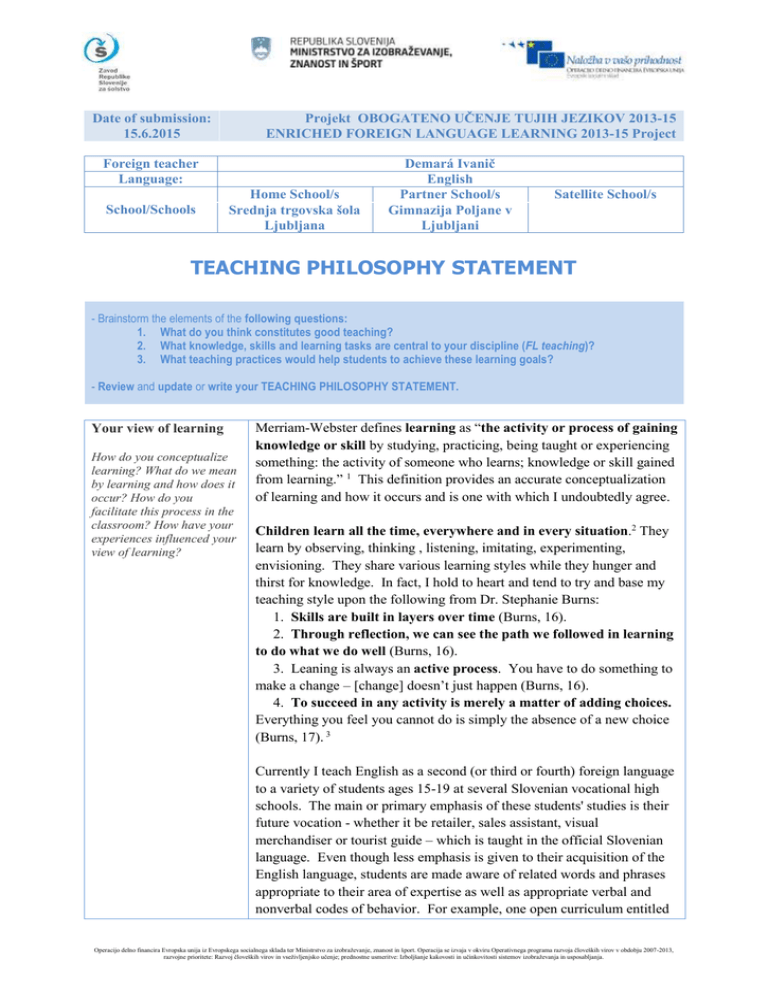
Projekt OBOGATENO UČENJE TUJIH JEZIKOV 2013-15 ENRICHED FOREIGN LANGUAGE LEARNING 2013-15 Project Date of submission: 15.6.2015 Foreign teacher Language: School/Schools Home School/s Srednja trgovska šola Ljubljana Demará Ivanič English Partner School/s Gimnazija Poljane v Ljubljani Satellite School/s TEACHING PHILOSOPHY STATEMENT - Brainstorm the elements of the following questions: 1. What do you think constitutes good teaching? 2. What knowledge, skills and learning tasks are central to your discipline (FL teaching)? 3. What teaching practices would help students to achieve these learning goals? - Review and update or write your TEACHING PHILOSOPHY STATEMENT. Your view of learning How do you conceptualize learning? What do we mean by learning and how does it occur? How do you facilitate this process in the classroom? How have your experiences influenced your view of learning? Merriam-Webster defines learning as “the activity or process of gaining knowledge or skill by studying, practicing, being taught or experiencing something: the activity of someone who learns; knowledge or skill gained from learning.” 1 This definition provides an accurate conceptualization of learning and how it occurs and is one with which I undoubtedly agree. Children learn all the time, everywhere and in every situation.2 They learn by observing, thinking , listening, imitating, experimenting, envisioning. They share various learning styles while they hunger and thirst for knowledge. In fact, I hold to heart and tend to try and base my teaching style upon the following from Dr. Stephanie Burns: 1. Skills are built in layers over time (Burns, 16). 2. Through reflection, we can see the path we followed in learning to do what we do well (Burns, 16). 3. Leaning is always an active process. You have to do something to make a change – [change] doesn’t just happen (Burns, 16). 4. To succeed in any activity is merely a matter of adding choices. Everything you feel you cannot do is simply the absence of a new choice (Burns, 17). 3 Currently I teach English as a second (or third or fourth) foreign language to a variety of students ages 15-19 at several Slovenian vocational high schools. The main or primary emphasis of these students' studies is their future vocation - whether it be retailer, sales assistant, visual merchandiser or tourist guide – which is taught in the official Slovenian language. Even though less emphasis is given to their acquisition of the English language, students are made aware of related words and phrases appropriate to their area of expertise as well as appropriate verbal and nonverbal codes of behavior. For example, one open curriculum entitled Operacijo delno financira Evropska unija iz Evropskega socialnega sklada ter Ministrstvo za izobraževanje, znanost in šport. Operacija se izvaja v okviru Operativnega programa razvoja človeških virov v obdobju 2007-2013, razvojne prioritete: Razvoj človeških virov in vseživljenjsko učenje; prednostne usmeritve: Izboljšanje kakovosti in učinkovitosti sistemov izobraževanja in usposabljanja. Prodaja v tujem jeziku, or Selling in the Foreign Language), provides students with a variety of contexts in which the foreign language is viewed as an applicable added value to a specialized area of study. As a native speaker teacher of English within the Slovenian educational system and former foreign language teacher of Spanish in the U.S., my main role is to assist and guide my students in furthering their English skills via team teaching and differentiated learning, respectively. Learning by doing should be increasingly included in foreign language learning within the Slovenian educational system. This is a process which takes time. Consistency, motivation and practice are part of that process. As a native speaker of English, I try to provide that consistency and motivation via dialogue. I enjoy using current lesson materials within the classroom, and I try to be innovative when creating original materials for different lessons while building upon what students’ have already learned. For example, I often create lessons that compare and contrast the Slovenian and American cultures. I have believed and still maintain that every child can learn – no matter what ability, age, gender, nationality, or race they are or what learning ability they possess or do not possess. My varied experiences both within and outside the classroom have proven and continue to prove this statement to be true. Your view of teaching What is teaching? What is the teacher's role in the classroom? How does teaching facilitate the learning process? How do you challenge students intellectually while supporting those with different learning styles and abilities? How have your experiences influenced your view of teaching? In order to state the teacher’s role in the classroom, a teacher must also consider the student’s role in the classroom. Ideally, students should arrive to class early, prepared and ready to learn. In the same way, the teacher should arrive to class early, prepared and ready to teach and energetically spur her/his students on. In the same way that students should be attentive, knowledgeable, open-minded, responsive and willing, the teacher should be just as willing to share his/her knowledge and experiences, open to learning and able to proactively accept criticism. Both teacher and student – when present in the moment and flexible to external influences - can use them to either inhibit, retard, or excel learning at any given moment. Students are inviduals, and each individual has his or her own needs. In the same manner, teachers each uniquely possess styles of teaching reflective of themselves and their past learning experiences. I try to facilitate the learning process by regularly including each student into a lesson by asking for either oral or written input. Student partcipation is key in creating an environment where both teacher and student opinions are valued. Ultimately, the teacher is a coach, a guide, a leader, a learner and a collaborator and thus a model of both teaching and learning. She or he is flexible, able to adapt to various educational settings and situations and willing to take risks. 4 My experiences within the Slovenian educational system have served to increase my appreciation for my varied experiences within the U.S. private and public educational system, where and when both students and teachers consistently sought after knowledge (if even reluctantly) and students and teachers respected each other, thus 2 making educational experiences and academic opportunities limitless. Consistency, respect, collaboration and open communication were key; and it was within this type of environment that the academic system was most successful, making unattainable goals attainable, and the ability to achieve the impossible a reality. Your teaching goals for students What do you expect your students to learn? What goals do you set for your classes and why? How do you work to help your students achieve your goals? What do you value in terms of student learning (e.g., writing, problem solving, critical thinking, content knowlege)? In retrospect, my most successful lessons are those lessons where I allowed for student thinking time. Additionally, these learning modules have proven to be even more meaningful and unified when thinking time and tracking student development/thinking processes are built into the lesson plans. In spite of limited class time, varying class schedules and other interruptions at the school level, I try to remain flexible, objective and positive. During my earlier years when teaching Spanish in the U.S.A., I often referred to an original picture file kept on hand in order to tap into the visual learning side of a student. I use the see-think-wonder technique and try to engage students in verbalizing their thinking: What does it make you wonder and What makes you say that? in order to extend not only students' prior and present knowledge as well as my own. Since I am new at teaching English to speakers of other languages, I often engage my students with the KWL (or KWLH) (What I know, What I want to know, What I learned, How can I find out more) graphic organizer or the 4W's and H (Why? What? When? Where? How?) when presenting a new topic. In addition, team-taught lessons pushed my coteachers and I to take student thinking a step further. I always had believed that if one could teach someone else, then he or she truly demonstrated mastery of content. I used to think that it was enough to ask What are the facts? or What are the good things? or What are the problems?. Now I think more about how: How do you want to think about this? How do you want to learn this? How does this way of learning differ from the previous way in which you were learning? How do you want to learn? My beginning students often doubt their own abilities in English, talk themselves down, and are greatly influenced by their peers because they are "outsiders" (just as I am) in a new country, new school system, and new way of life. While taking into account their differences, I try to use these differences and transform them into learning opportunities for my students and teaching opportunities for own professional and personal development. I used to think that I did not need to know much about the student to teach the student. As I reflected on my own positive learning experiences, I realized that my teachers did, in fact, know quite a bit about me, especially since I school was like my second home. So would it not follow that, I too, in order to be a more successful teacher, need to be well-aware of the prior knowledge my student brings into the classroom? I now challenge myself to think: How can I better help the student to extract that prior knowledge and use it to build new knowledge? How am I checking for misconceptions and when is the best time to do so? Am I using appropriate methods to communicate my 3 teaching content? In short, am I offering my students the absolute best deal? Putting your teaching philosophy to practice The most important component of your education philosophy statement is your elaboration of the different activities that you will implement to enable your students to achieve their goals. You have to illustrate how your perceptions of teaching and learning will be translated into real time class assignments. Since I believe that the purpose of education is to empower the learner and believe that students learn best by consciously taking the time it takes to know an object, subject, task, principle, etc., I am open to using different tools for learning and teaching, such as the KWL chart mentioned above or a specific type of interactive team teaching. I try to keep my students up-to-date on various methods or tools available for learning. I enjoy building on students’ previous knowledge, encouraging them to find new knowledge and make new connections and challenging them to apply this information to new situations. When I am teaching English, my main goal for my students is for them to master learning and to master the concepts which are being taught. Thus I believe that the most effective methods for teaching are attention, repetition, relevance, and meaning. I know this because it has worked for me (and still does work for me) for my own language learning. Your growth as a teacher How I grow as a teacher is perhaps best viewed via the classroom routines that I wish to improve. In order to continue growing professionally, teachers need to set goals for themselves and also outline their ways to achieve these goals. What personal goals have you have set for yourself as a teacher? There are many recurring routines in my classroom which often consists of a handful of students each semester to full classes. At the same time that I would like to teach my students English, I would also like teach them lifelong skills for learning in any language. In doing so, I wish to continue improving my class management skills by addressing behaviors (which typically show up at the beginning of the school year) which have proven inconsistent with my expectations: interrupting class when arriving late; addressing other students and interrupting the teacher; peering out the window; coming unprepared or without books, pen, and paper; or using a mobile phone in the classroom when it has been prohibited. I believe such behaviors are detrimental to building up students’ work ethic with which the teachers ultimately want to empower their future shop assistants: an excellent sales assistant arrives to work early, prepared to use his/her acquired knowledge and skills while exhibiting a positive attitude, read to go above and beyond to consistently and accurately perform the tasks at hand. With that said, my most difficult challenge will be inserting creativity into my lesson plans so that I am better able to maintain student interest throughout the school year while simultaneously allowing for sufficient thinking time at each lesson. 4 Cited Sources 1 Merriam-Webster, n.d. Web. 6 May 2014. <http://www.merriam-webster.com/dictionary/learning>. 2 "What Do We Learn in School That Couldn't Be Learned Eslewhere?" FifthEstate.org. N.p., Dec. 2013. Web. 16 May 2014. <http://www.fifthestate.org/archive/388-winter-2013/what-do-we-learn-inschool-that-couldnt- be-learned-elsewhere/>. 3 Burns, Dr. Stephanie (2000). Great Lies We Live By. NWS: Navybridge Pty Limited. 4 "21st Century Teacher." Educational-origami -. N.p., n.d. Web. 6 May 2014. <https://edorigami.wikispaces.com/21st+Century+Teacher>. 5
